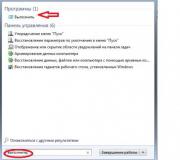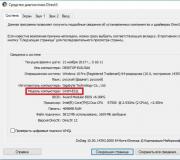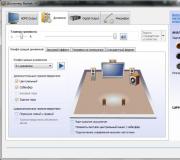Realtek HD Manager - where to find and how to set up
Many owners of built-in sound chips from Realtek, if they don’t use them in everyday work, at least know that the so-called “Realtek HD Manager” is very often used to configure this equipment. What kind of software it is, what it is used for, how to set it up correctly and whether it is worth keeping on a computer, then it is proposed to figure it out. Special attention will be paid to some common problems associated with the inoperability of installed drivers and related software.
What is Realtek HD Manager for Windows?
First, a few words about the software itself. This package was created specifically for Realtek soundcards embedded in Sound-on-Board class motherboards and discrete chips with support for high-quality sound, which is clearly indicated by the corresponding abbreviation in the name (HD - High Definition). However, it would be naive to think that Realtek HD Sound Manager is just some kind of software shell for managing playback settings and improving the sound atmosphere with many additional effects. In fact, this package also includes a complete set of drivers that ensure the correct operation of the computer's sound system. By the way, these drivers can also be used for equipment from other manufacturers, but only on condition of the declared support and compatibility.
Main advantages
As for the main features of such software, users mainly prefer it because it supports some hidden features of the sound card, which, when installed with standard drivers, may not be available for use. But the main advantages are most often called the following:
- full support for all known sound formats without installing additional codecs;
- high bandwidth sound;
- full support for surround sound technologies, even in computer games based on Sensaura technology;
- improved speech recognition when recording or entering voice commands;
- the ability to work with all Plug&Play plug and play devices.
If you pay attention to the last item on the list, it is easy to understand that the Realtek HD Manager itself can be used not only to configure equipment from this particular manufacturer, but also successfully used for other similar equipment without compromising sound quality and conflicts with devices. As a rule, this additional module is often installed directly during the installation of drivers, but only on the condition that "native" distributions are used for this, and not the Windows database.
Where can I find "Realtek HD Manager"?
As a control system element, this applet is usually presented in the corresponding section of the Control Panel, and sometimes (after installation) it can be activated in the system startup section and supplement the system tray with its own module that runs in the background.
But it also happens that there is no “Realtek HD Manager” in the “Control Panel”. Do not rush to blame the installed system or software for everything. It is possible that you downloaded the wrong distribution, or the installation was made with errors.
What should I do if this software is not available on my computer?
If there is no "Realtek HD Manager" in the "Control Panel", it may very well be that it is simply not installed on the system. The fact is that when installing "non-native" drivers, this situation is one of the most common.

In this case, it is recommended to go to the official resource of the developer and select the software module with codecs (High Definition Audio Codecs) from the list in the download section, save the installer on your hard drive, and then install this software yourself.
How to install this software correctly?
Installation usually does not cause problems even for the most unprepared user.

The main thing here is to pay attention to launching the installer exclusively with rights and on behalf of the administrator, and upon completion of the installation, perform the recommended immediate reboot. If, after that, "Realtek HD Manager" cannot be found in the system, the installation should be repeated by downloading additional packages. By the way, you can find out that the wrong driver (albeit a working one) is installed in the “Device Manager”, where on the driver tab the digital signature and the name of the supplier will correspond to Microsoft Corporation.
Also, when downloading the distribution separately, please note that some download links may contain something like "drivers only" in the description. This means that you only download the drivers without the dispatcher itself.
Right on the download page in the presented table at the very bottom, find an additional applet rack with 3D SoundRack effects.
However, if even after that the corresponding item is missing, or it is there, but the "Realtek HD Manager" does not start or is not visible in the system tray, it is quite possible that its display is simply disabled.
In this case, some experts advise moving on to editing the registry (regedit), in the HKCU branch, through the SOFTWARE section, find the RtkNGUI64 directory with the General subfolder, and in it, on the right, change the value of the ShowTrayIcon key from zero to one, and then reboot the system.
Sometimes on Windows 7 and above, after updating the drivers that are present in the R2.82 package, manually running the RAVCpl64.exe file from the HDA folder in the Audio directory, which is located directly in the Realtek program files directory, helps. When the "Realtek HD Manager" appears under the "OK" button, you need to click the icon marked with the letter "i", and then select the display of the applet in the tray icons. A reboot is usually not required, but it's best to do it just in case.
If, after that, the Realtek HD Manager does not start, most likely, you will need to disable automatic driver installation (which is most often required for Windows 10), and then repeat the installation of native drivers. Also, the problem may simply be that an unsupported sound card from another manufacturer is installed in the computer or laptop.
Basic parameters and sound settings
Now let's look at how to set up Realtek HD Manager. Basically the parameters are related to effects and the environment.
Here it is important to pay attention to the configuration of the speakers, as well as to take into account corrections for the type of room in which it is better to choose a room upholstered with felt (the sound will be softer). Effects, in principle, can be attributed to the standard type, but they can use many preset templates. Separately, it is worth dwelling on the quality and format of the sound. It is better to choose a depth of 24 bits and a sampling rate of 48,000 Hz. Here you can also configure the parameters related to the microphone.
More information and features
As additional features of the dispatcher, it is worth noting that it can be used to obtain information on the type of installed sound card and its driver, the audio controller used, and the version of the DirectX platform. In addition, you can use both digital and analog audio inputs or outputs, for which the main parameters are set automatically or using user settings.
Questions about installing additional codecs
Finally, if we talk about codecs, you usually don’t need to install anything additional to get high-quality sound when playing any audio or video format.
Although, if you wish, just in case, you can use the universal K-Lite package, and among the versions choose a mega-package (Mega Codec Pack), which contains the maximum possible number of codecs and decoders.
Results
To summarize, it can be noted that both the drivers and the dispatcher itself will be useful to all those users who cannot imagine listening to music or watching videos without crystal clear sound. The settings are quite simple. However, if similar parameters can be set using the system itself, the need for the dispatcher itself, by and large, disappears, since such options are identical (for example, they are all present in Windows 10). But for ease of management, the main program will do very well, even, according to some users, despite the somewhat overloaded graphical interface.
In the event of problems with starting, the above troubleshooting methods usually help. If the dispatcher for some reason still does not want to work, it may well be that the installed soundcard is simply not supported. In this case, there is absolutely no point in re-installing or editing the registry - it will not give the proper result anyway.



